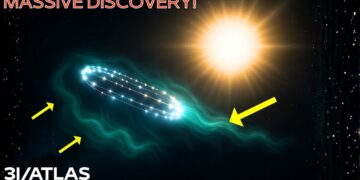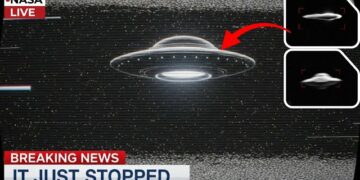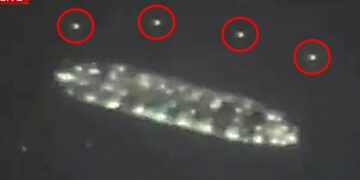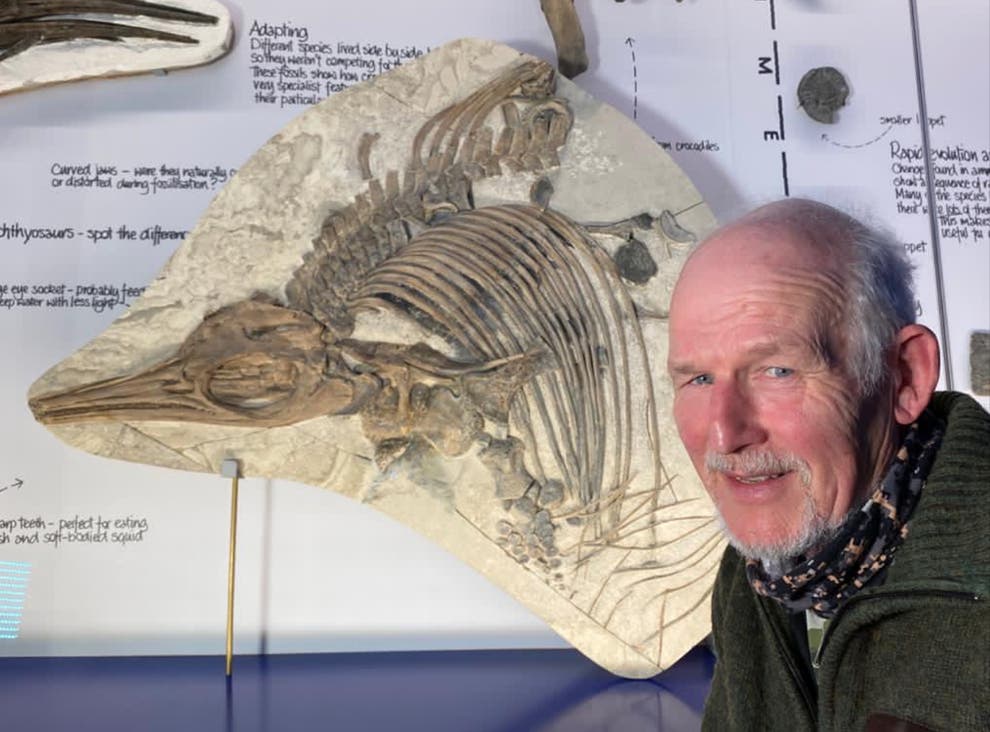Harvard astrophysicist Avi Loeb has proposed that the Three-Eye Atlas could be a form of alien technology. Three-Eye Atlas, an interstellar comet currently speeding through our solar system, is not traveling alone. Scientists have detected signals of nine other objects following in its wake, a discovery that raises more questions than answers. Are these fragments, part of a larger stream of interstellar debris, or are we witnessing something entirely new unfolding in real time? One thing is clear: Three-Eye Atlas is not the comet scientists anticipated—a true stranger in the dark.
Most comets follow predictable patterns. As they approach the sun, they heat up, develop a tail, and follow orbits that eventually bring them back. Three-Eye Atlas defies these rules. From the moment astronomers first spotted it, the data didn’t add up. It was moving too fast, on a trajectory no object in our solar system could dictate. This confirmed it wasn’t one of ours. As only the third confirmed interstellar object ever observed, it immediately shattered expectations.
Remarkably, in just the past decade, we’ve gone from spotting no interstellar visitors to identifying three. First came ‘Oumuamua in 2017, then Borisov in 2019, and now Atlas in 2025. Each has been uniquely strange. ‘Oumuamua resembled a long, tailless shard of rock. Borisov looked more like a typical comet but had an unusual chemical composition. Atlas, with its glowing tail, doesn’t align with anything familiar—it shines in unexpected colors and moves without the typical push from gas jets seen in comets.
This makes Atlas significant. It’s not just a rock passing through space; it’s a sample from another solar system, carrying unfamiliar ice, gas, and dust. Unlike ‘Oumuamua, which slipped away before thorough study, Atlas is lingering long enough for the world’s most powerful telescopes—Hubble, JWST, Gemini, and others—to lock onto it and extract every possible clue. It’s not our first interstellar visitor, but it’s the strangest yet.
When comparing Three-Eye Atlas to the two previous interstellar objects, the peculiarities become even more pronounced. ‘Oumuamua, the first in 2017, zipped through so quickly we barely had time to study it. It lacked a tail or visible coma, appearing as a flat, elongated object reflecting sunlight in a confusing way. Some speculated it was a rocky fragment from another world; others wondered if it could be artificial. It was gone before we could find answers. Then came Borisov in 2019, which looked more like a classic comet with a tail, dust, and gas—but its chemistry was off, with higher carbon monoxide levels than typical, suggesting it formed around a colder star. Atlas, at first glance, seemed like Borisov’s kin, with a glowing tail and gas release. But as data accumulated, it broke the mold again. Its shine, gases, and interaction with sunlight don’t align neatly with either Borisov or ‘Oumuamua. Atlas feels like a hybrid, with Borisov’s bright coma but behavior that echoes ‘Oumuamua’s mysteries.
This is why Atlas is under such intense scrutiny. With ‘Oumuamua, we were unprepared. With Borisov, we got lucky, but it faded quickly. Atlas, however, benefits from better timing, advanced instruments, and experience from the prior two. It’s our best opportunity yet to understand what these interstellar wanderers are and perhaps where they originate.
The Green Glow Mystery
One of the first things that set Three-Eye Atlas apart was its color. Most comets appear white or slightly bluish through telescopes, but Atlas developed a vivid green glow that became its hallmark. Typically, this glow results from C2 gas molecules breaking apart in sunlight, a common effect astronomers use to gauge comet chemistry. However, with Atlas, the explanation falters. Telescopic measurements showed C2 levels far weaker than expected for such a strong green hue, suggesting something else in the coma is producing the glow or that Atlas contains a unique mix of gases interacting in unfamiliar ways. The simple “it’s just C2” answer doesn’t hold.
The mystery intensified during the September 2025 lunar eclipse. Under dark skies, cameras captured Atlas glowing a striking green, brighter and more prominent than expected for its distance from the sun. The presence of this glow without confirmed C2 levels has sparked debate. Some propose trace amounts of C2 below detection limits, while others suggest another gas, possibly linked to Atlas’s high carbon dioxide content, could be responsible.
A Recipe from Another Star
The chemistry of Three-Eye Atlas clearly indicates it doesn’t belong here. Telescopic analysis revealed that water is not the dominant component in its coma; instead, carbon dioxide takes the lead. This is unusual compared to our solar system’s comets, where water ice typically drives the activity, vaporizing near the sun to form the coma and tail. Atlas, with its high carbon dioxide and lower water content, points to an origin in a colder region around a distant star, where carbon dioxide freezes in bulk while water remains less active. This comet carries the signature of a different planetary system, built with a recipe unlike ours.
Alongside carbon dioxide, astronomers detected carbon monoxide, traces of water, and icy grains in the dust. The ratios differ from those in local comets, confirming Atlas formed under alien conditions. Each spectrum and measurement adds to our understanding of how other solar systems function—not as theory, but as a tangible sample from another part of the galaxy, passing through our reach only once.
The Light That Behaves Wrong
Another surprise came from studying how sunlight scatters off Atlas’s dust. Typically, comets in our solar system show predictable polarization patterns at small phase angles, revealing details about dust grain size and structure. Atlas, however, exhibited extreme negative polarization, meaning its light scattered oppositely to nearly every other comet. The effect’s magnitude and the angle at which it flipped were also unusual, signaling that Atlas’s dust particles differ from those we know. Possible explanations include fluffy ice grains—fragile clusters that scatter light differently—or a composition with materials rare in our comets. This anomaly isn’t just a curiosity; it’s evidence that Atlas’s dust carries the signature of another solar system.
The Missing Push
Most comets experience a slight non-gravitational push from gas and dust jets, acting like tiny thrusters that alter their orbits. Atlas, despite its clear coma and tail, shows no such effect. Observations from May to September 2025 indicate its motion is governed almost entirely by gravity. This has led to two main theories: either Atlas is massive, with a nucleus several kilometers across and weighing tens of billions of tons, making gas jets too weak to affect its path, or its jets are symmetrically balanced, canceling out any net push. Both scenarios make Atlas exceptional, either as a massive interstellar body or one with unusually symmetrical outgassing.
The Clash Over Size
The debate over Atlas’s size is central. Hubble estimates the nucleus at up to 5.6 km across, large but within the range of our solar system’s biggest comets. However, the bright coma obscures the nucleus, so it could be smaller, perhaps a few hundred meters. Avi Loeb’s team, citing the lack of non-gravitational acceleration, argues for a massive, dense nucleus, possibly weighing 33 billion tons. This would make Atlas one of the largest interstellar objects ever detected. The disagreement matters, as size affects how bright Atlas may become near the sun, whether it will survive perihelion, and how much material we can study before it vanishes.
The Tail That Won’t Sit Still
Atlas’s tail is unusually dynamic, stretching and shifting rapidly. Images from Gemini South and amateur telescopes show it alternating between broad and diffuse to sharply defined. Some even capture rainbow-like colors in the coma, a result of light scattering through dust and gas. These changes stem from solar radiation, solar wind, and the nucleus’s rotation, but Atlas’s tail evolves more dramatically than most comets. Its rapid coma growth as it nears the sun makes it a moving target for telescopes, offering clues about its rotation, gas interactions, and dust properties. As Atlas approaches perihelion on October 29–30, 2025, its tail may grow larger and more complex, providing a real-time view of an interstellar comet’s response to solar heating.
A Broader Perspective
Three-Eye Atlas is only the third confirmed interstellar object, following ‘Oumuamua and Borisov. Their rapid succession—three in less than a decade—suggests many more may pass unnoticed. Our solar system is not isolated, and the galaxy is filled with such wanderers. Atlas, with its mysteries and anomalies, is a rare chance to study a piece of another star system up close, challenging our understanding and reshaping our view of the cosmos.























